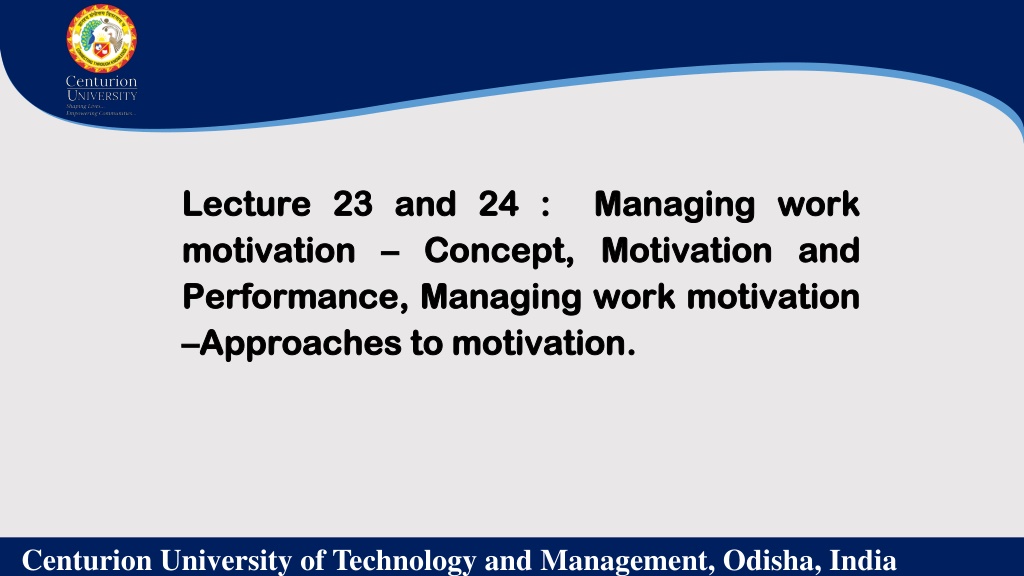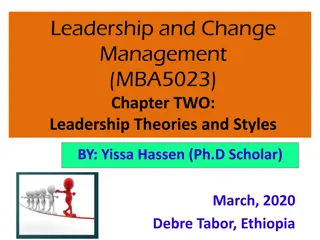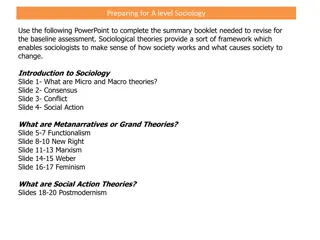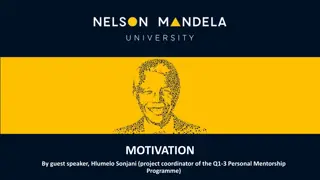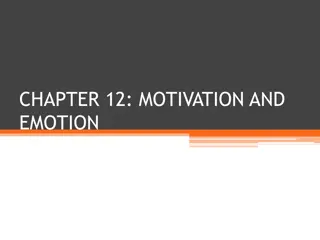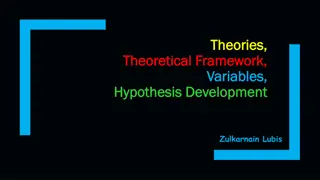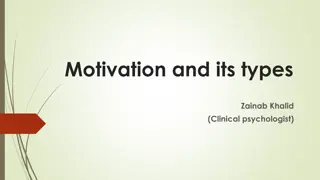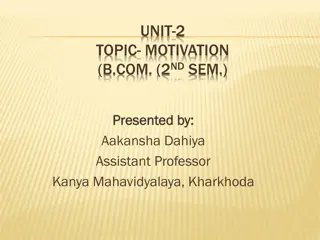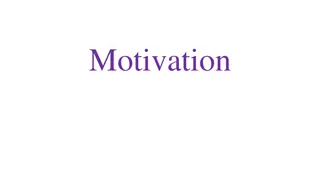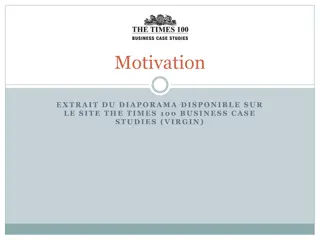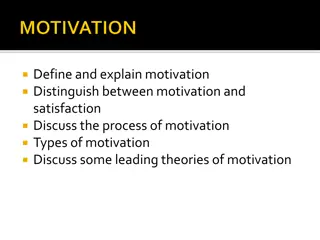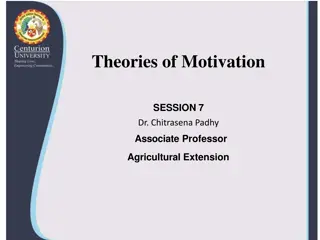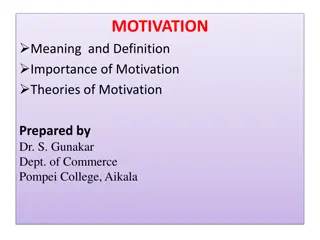Understanding Motivation: Concepts, Theories, and Approaches
Motivation is the driving force behind human actions, encompassing intrinsic and extrinsic factors. This article explores the importance of motivation in achieving goals, improving well-being, and avoiding negative behaviors. It delves into various theories of motivation, including content and process theories, and discusses different approaches to motivation such as the stick, carrot, and combined approaches to enhance workforce productivity.
Download Presentation

Please find below an Image/Link to download the presentation.
The content on the website is provided AS IS for your information and personal use only. It may not be sold, licensed, or shared on other websites without obtaining consent from the author. Download presentation by click this link. If you encounter any issues during the download, it is possible that the publisher has removed the file from their server.
E N D
Presentation Transcript
Lecture Lecture 23 motivation motivation Concept, Performance, Performance, Managing Approaches Approaches to 23 and and 24 Concept, Motivation Managing work to motivation motivation. . 24 : : Managing Managing work Motivation and work motivation motivation work and Centurion University of Technology and Management, Odisha, India
The term "motivation" describes why a person does something. It is the driving force behind human actions. Motivation is the process that initiates, guides, and maintains goal-oriented behaviors. Types of Motivation: Extrinsic motivation arises from outside of the individual and often involves external rewards such as trophies, money, social recognition, or praise. Intrinsic motivation is internal and arises from within the individual, such as doing a complicated crossword puzzle purely for the gratification of solving a problem. Centurion University of Technology and Management, Odisha, India
Why Motivation Is Important Increase your efficiency as you work toward your goals Drive you to take action Encourage you to engage in health-oriented behaviors Help you avoid unhealthy or maladaptive behaviors, such as risk-taking and addiction Help you feel more in control of your life Improve your overall well-being and happiness Centurion University of Technology and Management, Odisha, India
Theories of Motivation: Content theories: 1. Maslow s hierarchy of needs 2. Herzberg s two factor theory 3. McClelland s three needs theory 4. McGregor s theory of X & Y 5. Alderfer s ERG theory 6. Mayo s Motivation theory Centurion University of Technology and Management, Odisha, India
Process theories 1. Adam s equity theory 2. Vroom s expectancy theory 3. Taylor s motivation theory 4. Bandura s self-efficacy theory 5. Skinners reinforcement theory 6. Locke s goal setting theory Centurion University of Technology and Management, Odisha, India
What are the Different Approaches to Motivation? There are three distinct approaches to the motivational phenomena to ensure and boost worker productivity. They are the stick approach, the carrot approach and the combined carrot and stick approach 1. The Stick or Authoritarian approach This approach represents the oldest or classical view which compels performance through threats of penalties for failure. The industrialist was a dictator. He believed that might is right. With stick in hand the manager controls his subordinates. Centurion University of Technology and Management, Odisha, India
This was in vogue in the days of slavery. There are instances of slaves put to death for not doing what they were told to do. During these periods workers were completely under the thumb of their masters, subject to arbitrary overtime, arbitrary punishment, arbitrary fines and arbitrary dismissal. This approach is still followed in prison and military administration in all countries. In effect, the management tells the employee, Do what I tell you, otherwise I will sack you. This approach represents a negative attitude. Without positive motivation no good result can be obtained. The threat of punishment may dampen the spirit of the employees. Centurion University of Technology and Management, Odisha, India
2. The Carrot or Paternalistic approach This approach suggests that employees should be treated in a fatherly way as if the business organisation is a family and they are its dependent members. The employees are given rewards unconditionally. There is only carrot and no stick. The employers think that because of these rewards the employees will remain loyal and grateful and work hard, This approach does not motivate the workers. Ordinary workers do not have that sense of gratitude which the paternalist manager expects from them. So unconditional rewards will be just absorbed by them without any reciprocities behaviour. Centurion University of Technology and Management, Odisha, India
If one man has to play the role of benevolent supervisor, another has to play the role of grateful subordinate. No man can play the role of paternalistic employer successfully unless others will play the reciprocal roles of child-like employees. Paternalism means that papa know best. Management tells the employee- You do what I tell you because I shall look after your needs. By its very nature the paternalistic approach is unlikely to work with mature adult employees many of whom do not like their interests to be looked after by a godfather . They regard themselves as more competent to do so. This approach, however, can work, when the existing socio-cultural structure is congenial to the type of superior-subordinate relationship as in Japan and India and there are no strong labour organisations to challenge the manager s decisions about what should be done for the employees. Centurion University of Technology and Management, Odisha, India
2. The carrot and stick or exchange approach This combined approach suggests that with the stick in one hand, the manager will extract work against the threat of penalty and with the carrot in another; he will induce the worker to work harder in the hope of good rewards. The carrot and a stick approach is essentially a penalty-reward approach. If the worker produces more, he is given a bonus and if he produces less, he is penalised. The carrot approach provides for unconditional rewards, whereas the carrot and stick approach provides for both rewards and penalties which are linked directly to the level of performance. Centurion University of Technology and Management, Odisha, India
This approach can be identified with Taylors Differential Piece Rate System or with incentive wages system of modern times. It is also known as an exchange theory because it proposes to purchase quality and quantity of output. But the incentive scheme is not quite sound. It is based on the assumptions that the worker is fundamentally and continually motivated by economic considerations. The Hawthorne experiments proved that financial incentives are not enough. It is being increasingly realized that an employee works to satisfy some basic needs within himself. Consequently high employee productivity can be obtained when the organisation provides adequate opportunities for satisfaction of those needs through the work done. Centurion University of Technology and Management, Odisha, India
